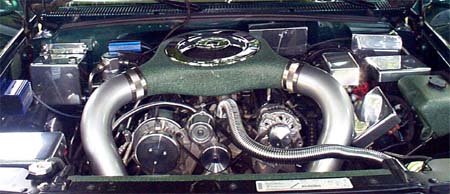You mean the catalytic converters are physically removed from the exhaust system? Who did that job?
The way the system works is the Engine Computer makes the fuel / air mixture too rich, then too lean. It switches back and forth about two times per second with the average being perfect. During the lean periods the unburned oxygen is stored in the catalyst, then during the rich times the unburned fuel is mixed with the oxygen and burned. The front oxygen sensor reports on how well the mixture is responding to the computer's control.
When the converter is working correctly the exhaust gas coming out of it will be a little lean for a long time, then a little rich for a long time. The switching rate is very slow, as in perhaps once a minute or two. When the catalyst starts to lose its efficiency the mixture takes less time to switch from rich to lean so the switching rate increases to maybe twice a minute. As the efficiency decreases even more, the switching rate speeds up more. When there's no change taking place in the composition of the exhaust gas the switching rates of the front and rear O2 sensors will be the same. That switching rate of the downstream sensor is what the computer looks at to determine how well the converter is working and when to set a fault code. The converters have nothing to do with engine performance unless they become plugged. Too much raw fuel going into the exhaust will overheat them and melt the material into a glob. The Check Engine light will flash when too much fuel is going into the converter. That's your warning to stop the engine right away before that damage occurs.
If you don't have the converter in the system the computer is going to set the efficiency code. That will cancel some of the other self tests performed by the computer so there can be a pile of other problems that won't be detected. The computer initiates things like momentarily going too lean to see if the converter responds as expected. When it has a fault code in memory, it knows it can't rely on that sensor as an accurate reference, so those tests won't run.
Code 161 is not an efficiency code. It means there's a problem with the heater circuit for that sensor. Usually that means a cut wire or corroded terminal in the connector. The heater could be burned out too but that is not very common.
All '96 and newer vehicles have this "OBD2" (on-board diagnostics, version 2) emissions system with upstream and downstream oxygen sensors, and catalytic converters between them, but that applies to cars and trucks sold in the U.S. If you're in a different country you may have the older emissions system but then you wouldn't have a downstream sensor. Your mechanic can connect a scanner to view live data that will show the switching rates of the converters. If the downstream sensors are switching very slowly, you have catalytic converters in the system and just didn't recognize them.
If someone removed them, the only thing I can suggest is to install replacements, check the wiring to the rear sensor on the passenger side, erase the stored fault codes, then see what new codes are set. There are well over 1000 potential fault codes. About half of them have to do with something that could potentially cause an increase in emissions, and those are the ones that must turn on the Check Engine light. About half of THOSE will result in high fuel consumption. Without a code to direct you to the circuit or system that's causing the excessive fuel usage you don't know if that is the cause, as in a leaky injector, or if it's the result, as in a vacuum leak that the computer is trying to correct for extra unburned oxygen in the exhaust. Without a code to get you started there are way too many things to check. Even on older vehicles with only a few dozen potential codes you could spend countless hours testing everything.
Thursday, June 18th, 2020 AT 1:15 PM
(Merged)




